WMG News
Fully electric masterclass created for the next generation of engineers
WMG High Value Manufacturing Catapult Centre is working with the Smallpeice Trust and the Faraday Institution to create and deliver a Fully Electric Challenge for year 11 students.
The online course has been created by a team of four WMG graduate trainee engineers, including Ben Hunt; Lauren Cooper; Irma Houmadi and Joshua Wallis, with support from the WMG Outreach team.
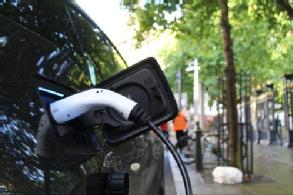 It aims to deliver key insights into the battery industry, provide an overview of transport electrification and explain how this translates to wider areas of society.
It aims to deliver key insights into the battery industry, provide an overview of transport electrification and explain how this translates to wider areas of society.
Students will have the opportunity to design and build an automotive product using engineering concepts and processes, before presenting their designs and ideas to their peers.
The course will also provide details on a variety of STEM career paths that can help contribute to a more sustainable future.
sustainable future.
Ben Hunt explained: “This is another great event to be involved in which highlights the exciting range of careers in STEM. I hope we manage to capture the multi-disciplinary nature of electrification during the four-day course, it really is a one-stop-workshop!
“It has been great to work alongside some fantastic professionals in designing the event and I’m looking forward to listening to their lectures myself. The event content is derived from their real-world experience across various industries so I am confident students will be as informed as they could be, certainly more than I was in my final school years!”
Lauren Cooper added: One of my favourite parts of my job at WMG is inspiring the engineers of the future by designing and delivering events like the Fully Electric Challenge. I think it is important to give students a taste of how exciting a career in engineering can be, and demonstrate the importance of STEM in the future world. Through the Fully Electric challenge, we aim to show how broad the subject of electrification is including aspects of battery technology, economics and policy for sustainability in transport as well as wider society. STEM careers provide so many opportunities to learn and make impact in society through the development of technology for electrification. Having studied chemistry and started my career as a graduate at WMG, I have really enjoyed learning how underlying battery chemistries are developed manufactured and implemented utilising knowledge and skills from other areas of STEM.”
Each year 124,000 new engineers and technicians are needed to meet current and future demands. The Smallpeice Trust is an educational charity that inspires young people to pursue careers in science and engineering through events and workshops.
It takes place from 9-13th August (except on 12th August - GCSE results day) from 9.30am to 1.30pm. Once registered each student is sent instructions, a guide to the activities and a kit enabling them to build a battery powered vehicle.
To register your place visit: https://www.smallpeicetrust.org.uk/course-page/8cbb5b40-ae76-eb11-a812-0022481a98e1
WMG launches student summer internship programme
 WMG has launched it’s 2021 summer internship programme for University of Warwick undergraduate students.
WMG has launched it’s 2021 summer internship programme for University of Warwick undergraduate students.
Approaches to learning are changing and the traditional model of mass lectures has evolved significantly - even more so in light of the COVID19 pandemic. New concepts of delivery, assessment, feedback and communication have changed the student journey considerably.
The eight-week programme offers students the opportunity to work with academic staff to explore and develop new concepts of teaching and learning (pedagogy). Whilst exploring these pedagogical possibilities, interns can gain research and employability skills.
2018 WMG summer intern, Severign Hagemeijer explains: “I think it was really valuable to do research in this area outside of my degree. It has given me a lot of helpful experiences (e.g. in setting up, doing, and presenting the research) and the entire process was just very enjoyable. I would completely recommend it to anyone.”
WMG Associate Professor, Angela Clarke, adds: I was over the moon with what Severijn was able to achieve in the space of eight weeks. Coming from a different department, he was able to bring a different perspective to this topic.”
Severign’s internship involved reviewing video assessments, and considering how they could be implemented, considering different approaches from both staff and students. The research was so useful that it has had a significant impact on the use of video assessment within WMG.
Angela added: “With Severign’s help we are now able to assess students more flexibly and innovatively.”
Find out more about the WMG Summer Internship Programme here: WMG Summer Pedagogical Research Internships (warwick.ac.uk)
Closing date for applications is 30th April 2021.
WMG battery experts publish Faraday Insight addressing battery degradation
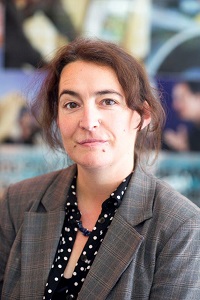 WMG Associate Professor Dr Mel Loveridge, and Principal Engineer Martin Dowson, have authored a special Faraday Insight entitled “Why Batteries Fail and How to Improve Them: Understanding Degradation to Advance Lithium-Ion Battery Performance,” a key consideration as we transition to a fully electric future.
WMG Associate Professor Dr Mel Loveridge, and Principal Engineer Martin Dowson, have authored a special Faraday Insight entitled “Why Batteries Fail and How to Improve Them: Understanding Degradation to Advance Lithium-Ion Battery Performance,” a key consideration as we transition to a fully electric future.
It is part of a collection, of pieces from leading UK battery experts, published by the Faraday Institution. The Faraday Insights are evidence-based assessments of the market, economics, commercial potential, and capabilities for energy storage technologies. The insights are concise briefings that aim to help bridge knowledge gaps across industry, academia, and government.
The briefing addresses key requirements in lifetime, performance and safety needed for LIBs to continue to lead electrification in multiple sectors, and explains why, to achieve this researchers need to better understand – and find ways to mitigate – the many causes of battery degradation.
Read the Insight here: www.faraday.ac.uk/get/insight-10/
Read more about WMG’s Electrochemical Engineering research here: Electrochemical Materials (warwick.ac.uk)
World’s largest public scenario database for testing and assuring safe Autonomous Vehicle deployments
§ It’s been widely stated that for Autonomous vehicles to be road-ready they have to be tested for at least 11 billion miles
§ For this to be viable virtual road scenarios must contribute towards these miles, and WMG at the University of Warwick and Deepen AI have made a globally accessible database of scenarios for Governments, manufacturers and researchers to test their autonomous vehicle technology
§ The Safety PoolTM Scenario Database and its role in enabling efficient testing will not only provide insights into the safety and readiness of Advanced Driver Assistance Systems (ADAS) and Automated Driving Systems (ADS), but will also help speed up the adoption of autonomous vehicles globally by providing the largest public scenario database in the world
The Safety PoolTM Scenario Database, the largest public repository of scenarios for testing autonomous vehicles in the world, has been launched today by WMG at the University of Warwick, and Deepen AI.
The database provides a diverse set of scenarios in different operational design domains (ODDs i.e. operating conditions) that can be leveraged by governments, industry and academia alike to test and benchmark Automated Driving Systems (ADSs) and use insights to inform policy and regulatory guidelines.
governments, industry and academia alike to test and benchmark Automated Driving Systems (ADSs) and use insights to inform policy and regulatory guidelines.
Initial scenarios have been generated using a novel hybrid methodology developed by WMG, at the University of Warwick, using both knowledge-based and data-based approaches. The Safety PoolTM Scenario Database will allow organisations to create scenarios in their own libraries, collaborate with other organisations via both shared and public libraries and enable the public to submit challenging real world scenarios.
Enabling scenarios to be matched to specific environments and operating conditions means that trials and tests can be undertaken in the simulated environment, controlled test facilities and on public roads, with evidence from each environment being used to inform our understanding of safe behaviours, bringing Autonomous Vehicles closer to market at pace.
It is becoming ever more apparent that Autonomous Vehicles and the Connected and Automated Mobility (CAM) that they enable are one of today’s most exciting technological advances with industry, academia and governments investing in the research and development of safe and secure Autonomous Vehicles.
CAM will provide a once in a lifetime opportunity to have a global impact on societal issues around road safety, traffic efficiency and emissions.
However, to ensure that Autonomous Vehicles are road-ready and will be safer than the average human driver, it has been suggested that they must be tested on 11 billion miles of roads, an insurmountable goal in the real world. Therefore, the ability to test on virtual roads in simulation environments is paramount for manufacturers and government bodies to ensure safe behaviours and assure that Autonomous Vehicles are a positive influence on road safety. The true test of an Autonomous Vehicles will not be in just the number of miles driven, but also the quality and complexity of those miles, leading to a wide spread industry adoption of a scenario-based testing approach to ensure that the Autonomous Vehicle’s behaviours and capabilities are ready for the real world.
Dr Siddartha Khastgir, from WMG, University of Warwick, holds a UKRI Future Leaders Fellowship enabling him to create methods to test autonomous vehicles over a seven year programme, having already worked on the UK Government’s Centre for Connected and Autonomous Vehicles and Innovate UK funded Midlands Future Mobility, which offers a real-world ecosystem for development and trialling of Connected and Automated Technology as part of the Zenzic coordinated CAM Testbed UK capability and was fundamental in the development of the scenario database which forms the core of Safety PoolTM initiative Siddartha stresses the importance of a global database of scenarios:
“Safety of automated driving systems is a hard research challenge and can only to solved by national and international collaboration and knowledge sharing. With the launch of Safety PoolTM Scenario Database, we are inching closer to seeing automated driving systems on the roads. Testing and validating automated driving systems transparently in an integrated simulation-based framework and in real-world scenarios will not only provide insights into the readiness of ADS, but also speed up the adoption globally. WMG and MFM are grateful for the support of CCAV and Innovate UK in developing the database and we are excited to be at the forefront of this revolution.”
“The Safety PoolTM Scenario Database lays a key foundation stone for autonomous vehicle safety” said Mohammad Musa, CEO & Co-founder of Deepen AI. “We are working closely with governments across the world to create a framework for ADS certification that will bring vehicle manufacturers one giant step closer to deploying safe and secure autonomous vehicles on the roads.”
AI. “We are working closely with governments across the world to create a framework for ADS certification that will bring vehicle manufacturers one giant step closer to deploying safe and secure autonomous vehicles on the roads.”
Scenarios in Safety PoolTM Database can be applied to a range of different autonomous vehicle systems, such as Automated Lane Keeping Systems (ALKS), which would see cars drive in an automated manner on motorways by adapting to speed and traffic around them, to trucking, to fully autonomous vehicles and even pods that could be used in town centres and pedestrianised areas as a ‘last mile’ mode of transport.
Safety PoolTM Initiative invites stakeholders to share learnings in the form of scenarios to expedite validation, testing and certification for the entire community.
Safety PoolTM Initiative is a global multi-stakeholder initiative with the mission of bringing transparent, certifiable safety to ADSs, uniting the autonomous vehicle community around standardised certification programs for ADSs worldwide.
Michelle Avary, Head of Automotive from World Economic Forum, comments:
“We are thrilled to work closely with Deepen AI & WMG, University of Warwick, to launch the Safety PoolTM Scenario Database. We believe Safety PoolTM Initiative is going to play a crucial role in standardising and bring transparency to ADS certification globally. We are already in advanced talks with many countries to adopt ADS certification frameworks based on Safety PoolTM database scenarios.”
Richard Morris, Innovation Lead for CAV at Innovate UK, comments:
“I am very pleased that the effort and hard work of producing this scenario database has been so successful and is now gaining the recognition it deserves. Scenario testing, both in simulation and physical tests, is widely recognised as the practical route to verifying the safety of ADS, and a comprehensive scenario database is crucial for that, and we are proud to have supported this work.”
Safety PoolTM initiative is welcoming government and industry stakeholders from all over the world to join the initiative and take the front row in bringing safety standards and certifications to their country. Members of the autonomous vehicle industry can also join the Safety PoolTM community and access safety scenarios to transparently test, validate and benchmark ADS. Visit http://www.safetypool.ai for more information.
ENDS
31 MARCH 2021
NOTES TO EDITORS
Images - credit WMG, University of Warwick.
Image scenario 1: Agent vehicle (red on the left) is cutting into ego vehicle's (grey) lane, while another agent vehicle (red on the right) is at front right position, on a motorway in a sunset condition
Image scenario 2: Ego vehicle (in black) is overtaking agent vehicle (red) on a motorway in a sunset condition.
Video available at: https://www.youtube.com/watch?v=YjO28ode6mU (credit WMG, University of Warwick)
Please visit https://www.safetypool.ai/ for more information.
About WMG, University of Warwick
WMG is an academic department at the University of Warwick and is the leading international role model for successful collaboration between academia and the public and private sectors, driving innovation in science, technology and engineering, to develop the brightest ideas and talent that will shape our future.
About Deepen
Deepen AI is a Silicon Valley based startup and the only safety-first data lifecycle tools and services company focused on machine learning and AI for autonomous systems. With tools and services that are customizable to suit the needs of enterprises as well as start-ups they have happy customers of every size across the globe. Visit Deepen.ai for more information.
About the Centre for Connected and Autonomous Vehicles
CCAV is a joint Department for Business, Energy & Industrial Strategy (BEIS) and Department for Transport (DfT) unit. Established in 2015, CCAV is an expert unit that is working with industry and academia to make everyday journeys greener, safer, more flexible and more reliable by shaping the safe and secure emergence of connected and self-driving vehicles in the UK.
Innovate UK
Innovate UK drives productivity and economic growth by supporting businesses to develop and realise the potential of new ideas, including those from the UK’s world-class research base. They connect businesses to the partners, customers and investors that can help them turn these ideas into commercially successful products and services, and business growth.
Coventry Very Light Rail tours its future home
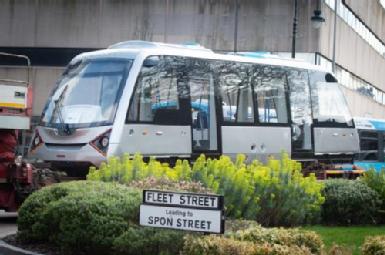 Coventry City Council’s prototype Very Light Rail vehicle, which has the potential to transform how people move about the city, is set to be moved ready for real on track testing.
Coventry City Council’s prototype Very Light Rail vehicle, which has the potential to transform how people move about the city, is set to be moved ready for real on track testing.
Over the last two years researchers from WMG, University of Warwick together with TDi Ltd, have been designing and building the new Coventry Very Light Rail vehicle for Coventry City Council, which will see an electric powered, zero-emissions, lightweight, rail-based public transport system arrive in Coventry.
The vehicle is being moved from NP Aerospace in the city for some static software testing before moving to a dedicated track at BCIMO in Dudley.
The prototype vehicle has done a tour of Coventry so it could see its future operational home. After leaving the vehicle production site in Coventry it stopped outside the Co-op building and the Transport Museum so that the public could get a better view.
Councillor Jim O’Boyle cabinet member for jobs and regeneration and Coventry and Warwickshire LEP board director said, “I am really pleased to see the first prototype vehicle out of the factory and on to our city’s streets. Even on a low loader it looks impressive – modern, sleek and of course the fact its battery powered means it’s good for the environment and air quality too.
“Very Light Rail has reached this really important point thanks to all of the researchers, innovators, engineers and manufacturing skills we have right here in the city. And I believe that we can create jobs and opportunities for local people as we lead the Green Industrial Revolution.
“Coventry was the beating heart of the carbon revolution and now with projects like this, UKBIC, our electric bus fleet and our plans for a Gigafactory we will lead the zero-carbon revolution too.
“On track testing will take some time – but it should prove the concept – and at that stage I expect there to be lots of interest in VLR from other areas of the UK and abroad. This is a very exciting moment.”
Dr Darren Hughes, from WMG, University of Warwick comments:
“It is very exciting for us to see the development of the Coventry Light Rail vehicle move onto the next phase of testing in Dudley, and to see the vehicle in the City which it will one day call home.
“The vehicle has been constructed within Coventry with a reliance on a regional supply chain where possible, showing the strength in depth of local manufacturing. It is a unique vehicle with state-of-the-art technologies including an advanced battery power-train and resilient glazing making it even safer for public use.”
Helen Martin, director of regeneration & enterprise at Dudley Council said: “The Very Light Rail Test Track and National Innovation Centre (NIC) is a key project for our borough. It will offer an innovative and exciting opportunity to provide lower cost local rail connectivity, encouraging shift from private vehicles towards public transport and creating economic benefits in terms of skills and supply chain opportunities.
“With the test track now completed, we’re looking forward to testing getting underway later this year.”
Darren Smith Head of TDI adds: “The TDI team are extremely pleased with the projects’ progress to date and the local benefits it has enabled. The work our supply chain, including our colleagues at NP Aerospace have engaged in, has produced an outstanding first off demonstrator for this hugely important and innovative project. The future economic benefits, both nationally and locally, this project will bring cannot be underestimated and TDI are very proud to be entrusted to deliver it for our client, WMG.”
James Kempston, CEO, NP Aerospace, comments: “Collaboration on the VLR project with WMG and TDI has been a great success, resulting in an exceptional prototype, which is ready to begin testing. The project has expanded our capability in the prototype vehicle industry and has enabled us to support a significant environmental transport initiative for the people of Coventry. It’s a very positive story for UK manufacturing with the challenges of the pandemic and Brexit and it’s particularly impressive what the team have delivered in just 8 months. We look forward to any future collaborations this may bring to the business.”
The BCIMO centre in Dudley is home to the test track developed as part of the wider research programme, on which they will now test the vehicle on to ensure that it performs as planned. Important trials will include the rapid battery charging system which will allow vehicle power to be replenished in minutes.
The project has been made possible thanks to funding from the Government’s Local Growth Fund through the Coventry and Warwickshire Local Enterprise Partnership (CWLEP) and the West Midlands Combined Authority Devolution Deal.
University of Warwick’s WMG and Engineering wins £5 million and key coordinating role in Government’s Driving the Electric Revolution programme
WMG and the School of Engineering at the University of Warwick have been awarded just over £5 million funding and a key coordinating role in the Government’s Driving the Electric Revolution Industrialisation Centre programme.
Government’s Driving the Electric Revolution Industrialisation Centre programme.
Driving the Electric Revolution is a UKRI (UK Research and Innovation) funded Industrial Strategy Challenge Fund (ISCF) technology programme to help achieve the UK’s net zero ambitions working across cars, aircraft, rail, marine, renewables, industrial digital technology, industrial power electronics, and machines & drives. It is investing £28.5 million into cutting edge equipment across the country.
WMG and the School of Engineering at the University of Warwick have been awarded the following equipment funding:
• Almost £4 million from UKRI and the High Value Manufacturing Catapult for a new Winding Centre of Excellence led by Dr David Simkin in WMG at the University of Warwick. The facility will help UK supply chain companies to manufacture discrete hairpin machines.
• An award in order of £1.3 million from UKRI and High Value Manufacturing Catapult for the University of Warwick’s School of Engineering for a facility led by Professor Phil Mawby and focusing on power electronics reliability and failure analysis.
WMG at the University of Warwick has also been selected to provide leadership to the Midland’s region Driving the Electric Revolution Centre, which is one of four across the UK. These centres will coordinate and build on the UK’s national capability to deliver long-term sustainable growth on the road to net zero. Together they will help businesses scale up the use of electric-powered vehicles and machines across a range of industries and transport systems to grow the UK supply chain.
Margot James, Executive Chair at WMG, University of Warwick said: “We are delighted that Warwick is leading such an important project in the UK’s effort to build a net zero future. The green agenda will contribute significantly to our economic recovery and growth, with zero carbon transport crucial to protecting our planet. It’s encouraging to see an opportunity for UK businesses to work together, through the Centres, to deliver on the sustainable transport challenge.
Professor Will Drury, Driving the Electric Revolution Challenge Director said: “This investment represents a vital step forward in making the UK a world leader in Power Electronics, Machines and Drives (PEMD). With access to the Centres and network open to all, we aim to give all UK businesses and researchers the ability to develop and scale new PEMD technologies and manufacturing processes. Only by investing now in developing PEMD will the UK achieve its net zero ambitions.”
Dr. Andreas Docter, Director Electric Powertrain, Jaguar Land Rover said: “This is a great opportunity to support the most advanced projects in the development and testing of Power Electronics, Machines & Drive (PEMD) systems. Jaguar Land Rover has a specific interest in projects which improve manufacturing processes, accelerate the PEMD manufacturing innovation to production and an important one is flexible eDrive prototyping. These all contribute to the company’s mission of achieving Destination Zero.”
David Bock MIET, @FutureBEV Technical Lead BMW AG said: “@FutureBEV is pleased to be working with University of Warwick as a strong partner in the development of next generation powertrain development and core component development within the APC15 @FutureBEV programme. University of Warwick’s place in the Government’s Driving the Electric Revolution programme will provide value in the @FutureBEV reinforcing the knowledge transfer to real products that will influence the concept to product delivery within the program and in steering the next generations of engineers into the industry. The UK supply chain needs this capability, and this provides a strong path to delivering best in class power electronics to market as well as the needed skill base for future delivery into the value chain.
ENDS
23 MARCH 2021
For further information please contact:
Alice Scott
Media Relations Manager – Science
University of Warwick
Tel: +44 (0) 7920 531 221
E-mail: alice.j.scott@warwick.ac.uk
UKRI
To arrange an interview Professor Will Drury please contact: press@ukri.org.
Notes for Editors:
Any business or researcher interested in using a Driving the Electric Revolution Industrialisation Centre should visit www.der-ic.org.uk.
Funding
The funding comes from Driving the Electric Revolution. Part of the Industrial Strategy Challenge Fund (ISCF) delivered by UK Research and Innovation (UKRI). Driving the Electric Revolution started in August 2019 as part of the ISCF programme. The programme is funded by £80 million from the government’s ISCF Future of Mobility grand challenge and aims to secure £154m private investment. It aims to make the UK a global leader in the manufacture of core technologies which support electrification: Power Electronics, Machines and Drives (PEMD). It seeks to accelerate the journey into the growth of PEMD supply chain in the UK.
The ISCF
ISCF aims to bring together the UK’s world leading research with business to meet the major industrial and societal challenges of our time. The fund was created to provide funding and support to UK businesses and researchers, part of the government’s £4.7 billion increase in research and development over the next 4 years. It was designed to ensure that research and innovation takes centre stage in the Government’s modern Industrial Strategy. It is run by UK Research and Innovation.
UKRI
UKRI is the largest public funder of research and innovation in the UK, with a budget of over £8bn. It is composed of seven disciplinary research councils, Innovate UK and Research England.
We operate across the whole country and work with our many partners in higher education, research organisations businesses, government, and charities.
Our vision is for an outstanding research and innovation system in the UK that gives everyone the opportunity to contribute and to benefit, enriching lives locally, nationally and internationally.
Our mission is to convene, catalyse and invest in close collaboration with others to build a thriving, inclusive research and innovation system that connects discovery to prosperity and public good.
UKRI continues to support the research and innovation community to navigate the transitions associated with the exit of the UK from the EU. To keep up to date please visit our dedicated pages. https://www.ukri.org/research/international/ukri-eu-exit/
Lone musicians to play with virtual ‘timing-sensitive’ colleagues in a new immersive rehearsal platform
A system that will enable musicians to play alone, but as if part of a live ensemble, is being developed by researchers from WMG, University of Warwick, led by the University of Birmingham.
In situations where musicians are unable to be together, the system will offer the experience of a group rehearsal. Being unable to meet has been an issue for musicians throughout the Covid-19 pandemic, and is an ongoing challenge for players looking to explore and rehearse music without access – for whatever reason – to their colleagues.
Be it piano duets, jazz trios, string quartets or rock groups, mutual listening and timing is key to good performance. Ensemble musicians spend hours working together to hone such timing abilities and so achieve group coherence worthy of a stage.
When unable to rehearse together, individual ensemble musicians may choose instead to play along with a recording of the piece, sometimes even one with their own track omitted. The drawback of this approach is that they miss the vital interactive and dynamic elements of a group rehearsal. Meanwhile attempts to rehearse using video-conferencing are prone to failure, with internet delays rendering split second synchronization – the holy grail of good ensemble – impossible.
ARME – Augmented Reality Music Ensemble – is a system being developed by a collaborative team across three West Midlands Universities and two UK companies specialising in digital music technology.
 It presents the lone musician playing a real instrument with a group of virtual colleagues based on audio-visual recordings of professional players. Crucially, each virtual player is timing-sensitive, meaning that their musical timing is individually modulated in real time using mathematical models. Such sensitivity allows for the virtual players to synchronise ‘live’ with each other and with the real player, so mimicking the experience of an actual rehearsal.
It presents the lone musician playing a real instrument with a group of virtual colleagues based on audio-visual recordings of professional players. Crucially, each virtual player is timing-sensitive, meaning that their musical timing is individually modulated in real time using mathematical models. Such sensitivity allows for the virtual players to synchronise ‘live’ with each other and with the real player, so mimicking the experience of an actual rehearsal.
Starting out with small groups of classical string players, in duos, trios, and quartets, the team hopes to create a model that can then be broadened out to other ensembles and genres, leading to a versatile, interactive rehearsal tool to be used when traditional ensemble rehearsals are not accessible.
The £1.2M project funded by the Engineering and Physical Sciences Research Council, part of UK Research and Innovation, is a joint project involving researchers at Birmingham City University, University of Warwick, and led by the University of Birmingham (UoB).
Supporting the project, the UK digital music industry is represented by two commercial partners involved in musical training and digital technology: PartPlay and Semantic Audio.
Dr Mark Elliott, from WMG at the University of Warwick comments: “This is a great example of how the collaborative expertise across three West Midlands Universities and industrial partners will be used to combine state-of-the art immersive and audio technologies with mathematical models of human movement to develop research into realistic musician avatars.”
Dr Maria Witek, a Senior Research Fellow in the Department of Music (UoB), explains: “By studying how ensemble musicians adapt their timing to achieve a rhythmically cohesive and musically expressive performance, we can develop a novel system allowing a real musician to play with responsive and adaptive virtual players.”
Dr Massimiliano Di Luca, principal investigator and senior lecturer in the School of Psychology (UoB) highlights the opportunity for inclusivity and accessibility that the system offers: “We will be able to provide musical training opportunities when travel and social rehearsals are not feasible. This will be useful in the wake of the Covid-19 pandemic and for musicians who might – perhaps for geographical, financial or societal reasons – be unable to make rehearsals happen.”
ENDS
23 MARCH 2021
NOTES TO EDITORS
For further information please contact:
Alice Scott
Media Relations Manager – Science
University of Warwick
Tel: +44 (0) 7920 531 221
E-mail: alice.j.scott@warwick.ac.uk
WMG in landmark partnership to develop UK electric motorcycle capability
Researchers at WMG are part of a unique four-way partnership with Triumph Motorcycles, Williams Advanced Engineering and Integral Powertrain Ltd e-Drive Division, focusing on developing specialist electric motorcycle technology and innovative integrated solutions.
 Phase 2 of Project TE-1, a landmark four phase collaboration in British design and engineering, is now complete with the exciting reveal of the innovative advanced electric powertrain and battery, and the very first styling sketches for the final prototype.
Phase 2 of Project TE-1, a landmark four phase collaboration in British design and engineering, is now complete with the exciting reveal of the innovative advanced electric powertrain and battery, and the very first styling sketches for the final prototype.
Including innovation in battery and powertrain design, initial test performance results that far exceed the current benchmarks and industry targets and development in efficiency and range technology, Project TE-1 is well on track to fully deliver on the partnership’s objectives to enhance the credibility and profile of British industry and design, and provide substantial input into future electric motorcycle strategy from Triumph.
Nick Bloor, Triumph CEO said: “The completion of Phase 2, and the promising results achieved to date, provide an exciting glimpse of the potential electric future and showcase the talent and innovation of this unique British collaboration. Without doubt the outcome of this project will play a significant part in our future efforts to meet our customer’s ambition and desire to reduce their environmental impact and for more sustainable transportation.
“This important project will provide one of the foundations for our future electric motorcycle strategy, which is ultimately focussed on delivering what riders want from their Triumph; the perfect balance of performance, handling and real world usability, with genuine Triumph character.”
Truong Quang Dinh, WMG’s Assistant Professor of Energy Management and Control Systems explained: “Our creation of initial computer-based simulation models at the start of Phase 1 has been instrumental in ensuring that the component selection was appropriate to achieve the performance targets defined by the partners for the TE-1 Prototype. We have continued with this work across Phase 2 of the project, refining the models to a much more complex level to allow us and the partners to imitate further components on the bike such as braking, throttle, lighting and other systems and mimic real-world riding to provide development opportunities before components were fully designed. Additionally we have created a physical rig wired with all of the control units, in order to implement a design validation test programme to ensure the function of each section was within the allowable range.”
Truong Quang Dinh explains more here: Project TE-1 - WMG cut on Vimeo
WMG has also been providing guidance to Triumph relating to future legislation, charging infrastructure and recycling strategies.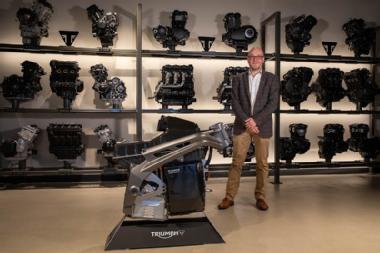
Project TE-1, a two year project, is supported and co-funded by the UK Government’s Department for Business, Energy & Industrial Strategy (BEIS) and the Office for Zero Emission Vehicles (OZEV), via Innovate UK.
Read more about the Project here: Project Triumph TE-1 | For the Ride (triumphmotorcycles.co.uk)
Read more about WMG’s energy research here: Energy (warwick.ac.uk)
COVID-19 related Cyber-attacks leveraged Government announcements
There has been a remarkable surge in cyber-security crime experienced during the global COVID-19 pandemic, with a particular significance between governmental policy announcements and cyber-crime campaigns. A consortium of researchers, including WMG, University of Warwick report that some days as many as 3 to 4 new cyber-attacks were being reported.
The COVID-19 pandemic created a new normal for billions of people around the world, with people working from home, ordering shopping and socialising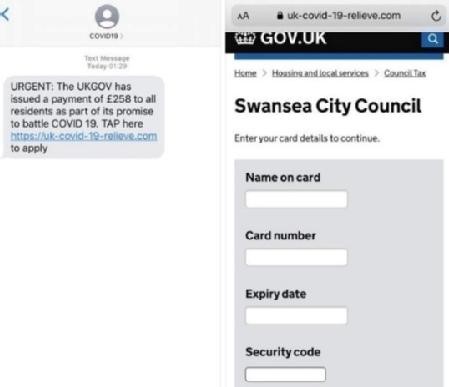 online as shops and businesses were closed. However, with an increased amount of people being online, an increase in cyber-attacks has also been found.
online as shops and businesses were closed. However, with an increased amount of people being online, an increase in cyber-attacks has also been found.
Researchers from WMG, University of Warwick, Abertay University, University of Kent, University of Oxford and University of Strathclyde worked in collaboration in the study, ‘Cyber Security in the Age of COVID-19: A Timeline and Analysis of Cyber-Crime and Cyber-Attacks during the Pandemic,’ published in the journal Computers & Security.
By using the UK as a case study, the paper reveals the explicit connection between governmental policy announcements and cyber-crime campaigns. Although this is a pattern that’s been suspected for a while, this is the first analysis from 100s of cases around the world which makes this connection clear.
Since the outbreak of the pandemic in 2019 there have been reports of scams impersonating public authorities such as the World Health Organisation, and organisations such as supermarkets and airlines targeting support platforms such as PPE and offering COVID-19 cures. They often target the public, who are now socialising and spending more time online in general, as well as the increased population of people who are working from home.
Such scams can be sent by text or e-mail, and in most cases a URL pointed to a fake institutional website which requests debit/credit card details.
In order to support ongoing research, the researchers have proposed a novel timeline of 43 cyber-attacks related to the COVID-19 pandemic. This timeline and the subsequent analysis can assist in understanding those attacks and how they are crafted, and as a result, to better prepare to confront them if ever seen again.
They found that from the point that the first case was announced in China (8/12/19) the first reported cyber-attack was 14 days later. From this point onwards the timeframe between events and cyber-attacks reduced dramatically.
The cyber –attacks were categorised, and it was found:
• 86% involved phishing and/or smishing
• 65% involved malware,
• 34% involved financial fraud
• 15% involved extortion
• 13% involved pharming
• 5% involved hacking
• 5% involved denial of service
Dr Harjinder Lallie, from WMG, University of Warwick comments:
“The analysis presented in this paper has highlighted a common modus-operandi of many cyber-attacks during the coronavirus period.
“Many of the cyber-attacks begin with a phishing campaign which directs victims to download a file or access a URL. The file or the URL act as the carrier of malware which, when installed, acts as the vehicle for financial fraud. The analysis has also shown that to increase the likelihood of success, the phishing campaign leverages media and governmental announcements. In fact some days we recorded as many as 3-4 new scams.”
Dr Xavier Bellekens from the University of Strathclyde, said: “Over the last year we have seen a surge in cyber-attacks targeting critical infrastructures, governments, organisations and end-users, influenced by governmental announcements. These have ranged from targeted attacks to selling counterfeited respirators to hospitals, denying of essential services through ransomware, selling fake online Covid-19 testing equipment as well as more recently, generating fake Covid travel tests.
“These techniques, while common, had never been observed in relation to an event of this magnitude, making this study unique.”
Dr Lynsay Shepherd of Abertay’s Division of Cybersecurity said:
“Cybercrime is a highly sophisticated and organised activity and it did not come as a surprise to anyone in the cybersecurity industry that these individuals and groups used the Covid-19 pandemic as a vehicle to launch attacks.
“It is unlikely there will ever be a time when we can eradicate cybercrime. Therefore we must continue to educate everyone from as early a stage as possible, train our graduates to understand the mindset of cybercriminals as we do at Abertay, and to continue to invest in research, development, innovation and infrastructure.”
Dr Jason Nurse from the Institute of Cyber Security for Society (iCSS) at the University of Kent said:
“Covid-19 has had a substantial negative impact on society, and this impact, as we show in our new research, has also meant a notable increase in cybercrime globally.
“There are several significant novel findings emerging from our analysis, but the one I found most salient was the targeted use of threats, scare tactics and fake incentives within attacks. Cybercriminals clearly understood that many people would be anxious, worried, distracted and away from their support networks (personal or work-related), and sought to exploit this as much as possible. I hope our research can provide a pathway for future work into faster reaction to these cyberattacks, and also increase society’s awareness of their prevalence.”
Dr Arnau Erola, from the Department of Computer Science at the University of Oxford adds:
“Cybercriminals take any opportunity to their advantage. By getting insights on their modus operandi, polices to tackle cybercrime can become more effective. This is not only deterring cybercriminals from their unlawful activities but also educating the society about improper and unethical actions.”
ENDS
22 MARCH 2021
NOTES TO EDITORS
Full list of researchers include:
Dr Harjinder Lallie (University of Warwick)
Dr. Lynsay Shepherd (Abertay University)
Dr. Jason R.C. Nurse (University of Kent)
Dr. Arnau Erola (University of Oxford)
Dr. Gregory Epiphaniou (University of Warwick)
Professor Carsten Maple (University of Warwick)
Dr. Xavier Bellekens (University of Strathclyde)
High-res images available at:
https://warwick.ac.uk/services/communications/medialibrary/images/march_2021/scam_1.jpg
Caption: An example of a scam pointing a fake institution
https://warwick.ac.uk/services/communications/medialibrary/images/march_2021/scam_2.png
Caption: A timeline of scams worldwide between December 2019 and 31st March 2020
Paper available to view at:
https://doi.org/10.1016/j.cose.2021.102248
FOR FURTHER INFORMATION PLEASE CONTACT:
Alice Scott
Media Relations Manager – Science
University of Warwick
Tel: +44 (0) 7920 531 221
E-mail: alice.j.scott@warwick.ac.uk
Associate Professor receives Fellowship from the Institute of Mathematics and its Applications
 WMG’s Associate Professor, Dr Mark Elliott, has been accepted as a Fellow of the prestigious Institute of Mathematics and its Applications (IMA).
WMG’s Associate Professor, Dr Mark Elliott, has been accepted as a Fellow of the prestigious Institute of Mathematics and its Applications (IMA).
Fellows require senior professional standing based on demonstrable achievement and competence in the development or application of mathematics.
Dr Elliott explains: "Mathematics has underpinned all the disciplines I have worked in during my research career, covering engineering, experimental psychology and most recently, digital health. So, it is great to join this important institution as a Fellow."
Dr Elliott is based in WMG’s Institute of Digital Healthcare (IDH), with his core research focusing on human movement analytics. His research uses data science approaches to monitor, measure and model movement in a range of different contexts. His current research focusses on developing movement related technologies and data analysis methods in the areas of osteoarthritis, physiotherapy and physical activity.
Read more about Dr Elliott’s research here: WMG :: Our People :: Profile (warwick.ac.uk)
